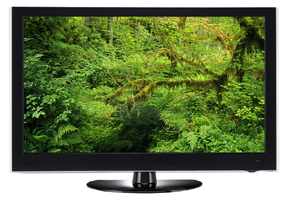 According to the U.S. Department of Energy, Americans’ 275 million TV sets burn through some 65 billion kilowatt hours of energy each year, representing four to five percent of U.S. household electricity consumption. Each U.S. household spends around $200/year for electricity to power their TVs and related equipment.
According to the U.S. Department of Energy, Americans’ 275 million TV sets burn through some 65 billion kilowatt hours of energy each year, representing four to five percent of U.S. household electricity consumption. Each U.S. household spends around $200/year for electricity to power their TVs and related equipment. While screen size has continued to increase, the overall mass of televisions is much smaller than back in the days of boxy cathode ray tube (CRT) sets. And many new flat screen models (LCD, OLED or plasma) sport hyper-efficient screens that can be tweaked even further by the user to reduce their power needs.
“Even though televisions are the most widely owned device in the U.S., with a 97 percent household penetration in 2013, their total annual electricity consumption dropped 23 percent from 2010,” reports the Consumer Electronics Association (CEA), the trade group for electronics manufacturers that puts on the annual Consumer Electronics Show in Las Vegas.
The U.S. Environmental Protection Agency’s (EPA’s) ENERGY STAR program certifies appliances, electronics and other energy-efficient consumer items to help Americans save money and protect the climate through saving energy. If you’re shopping for a new TV, start your search at EnergyStar.gov, where you can find and compare new models that are all at least 25 percent more energy efficient than conventional ones.
The easy-to-use site allows you to check-off which brands, screen sizes, technology types, resolutions, and other features you’re looking for before it serves up a list of matches complete with estimated energy use over a year. The EPA reports that if every TV, DVD player, and home entertainment system purchased in the U.S. this year qualified for an ENERGY STAR label, consumers would keep some 2.2 billion pounds of greenhouse gas emissions out of the atmosphere, the equivalent of taking 200,000 cars off the road.
Of course, buying a new TV introduces another potential environmental hazard: that associated with the disposal of your old set. Throwing your old TV in the garbage where it will end up in a landfill is not only bad for the environment, given the risk of chemical and heavy metal leakage, it is also typically illegal. If you’re buying your new TV from a local store, ask them if they can take back your old set. Also, the CEA’s Greener Gadgets website provides an up-to-date list of resources to find out how to responsibly recycle old TV sets and other electronics directly with the manufacturers or through third-party recyclers.
EarthTalk® is produced by Doug Moss and Roddy Scheer and is a registered trademark of Earth Action Network Inc. View past columns or e-mail us your question:











 "Saartjie" Baartman’s
"Saartjie" Baartman’s


